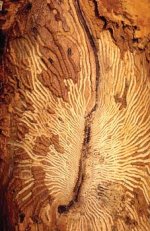Common menu bar links
Scolytus ratzeburgi (Janson) - Birch bark beetle
Coleoptera: Scolytidae
IDENTIFICATION
Adults are 4.5 to 6.5 mm, cylindrical, shiny black or brown.2 Males have a long flat frons covered with dense hairs.2 The pronotum is finely punctured.2 Elytra are flat with punctured grooves and interstices, the posterior portions are smooth.2 The legs and antennae are brown.2
HOST TREES
LOCATION OF INFESTATION WITHIN THE TREE
Immature beetles maturation feed on bark, buds, leaves, and thin twigs in the crown.68 Larvae usually develop beneath the thick, coarse bark of the main stem or large branches (less than 40 cm in diameter) but may occasionally develop in the smooth bark of smaller branches (5 to 7.5 cm in diameter).68
HOST CONDITION
Old and weakened trees. Healthy trees are attacked during outbreaks.2
DISTRIBUTION
Europe, Central and Eastern Russia, Mongolia and Japan.17
SIGNS AND SYMPTOMS
Immature beetles feed on fresh young twigs and branches of host trees.68 They also feed on leaves but do not consume the leaf stalk.68 Beetles bore a semi-circular gallery into the bark beneath the nodes.68 These galleries are 1 to 2 cm long.68 Callus tissue may occur over old maturation galleries.68 In some cases galleries are not formed, but the bark is gnawed away in irregular patches.68 Sometimes the maturation galleries are used as breeding sites. Otherwise, these galleries are abandoned and new ones are constructed for egg laying.68
Females initiate the attack. Entrance holes, shaped like the head of a golf club, are easily visible on smaller branches with thinner bark, but are difficult to find on thicker bark.68 Females bore straight into the sapwood, then bore longitudinally along the axis of the bole. Reddish-brown frass is usually pushed out by females as they excavate the egg gallery.68 Monoramous, longitudinal egg galleries are 0.75 to 10 cm long and etch the sapwood.2, 68
Eggs are laid in small niches on each side of the egg gallery and are packed with frass.68, 131 At right angles to the egg galleries, long larval galleries (6 to 10 cm long) penetrate the sapwood as well as the bark.2, 68, 89 As larvae grow the galleries approach the surface, with pupal chambers occurring just under the bark.68
Other signs of attack are the conspicuous ventilation holes in bark that are 2.5 mm in diameter.2, 88 These holes are initially round, but become oval with use.2 Dry crowns and die-back also occur on attacked trees.2
Scolytus ratzeburgi is associated with the occurrence of Dutch elm disease, facilitating the spread of this disease.68

A - Adult S. ratzeburgi (4.5-6.5 mm long).

B - S. ratzeburgi egg and larval galleries.

C - S. ratzeburgi egg (0.75-10 cm long) and larval (6-10 cm long) galleries.

D - S. ratzeburgi egg and larval galleries.

E - S. ratzeburgi ventilation holes (2.5 mm wide).

F - Dieback on S. ratzeburgi attacked tree.
Photo credits
- A A.G. Kirejtshuk, Zoological Institute of Russian Academy of Sciences
- B Karl-Heinz Apel, Landesforstanstalt Eberswalde, Abteilung Waldschutz
- C Erkki Annila, Finnish Forest Research Institute, www.metla.fi
- D Erkki Annila, Finnish Forest Research Institute, www.metla.fi
- E Till Tolasch, www.koleopterologie.de
- F Erkki Annila, Finnish Forest Research Institute, www.metla.fi
